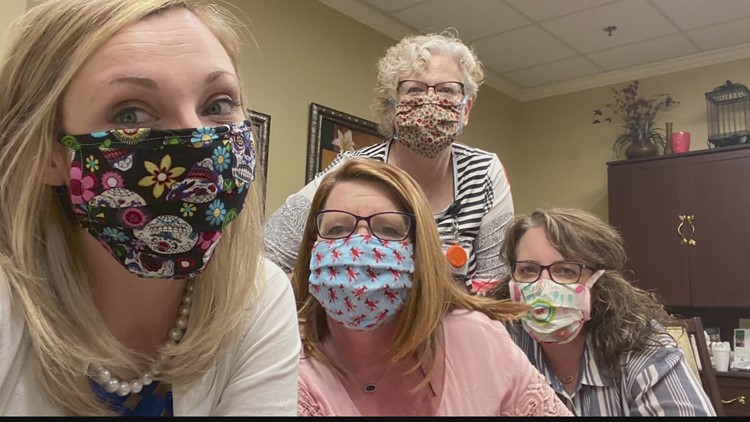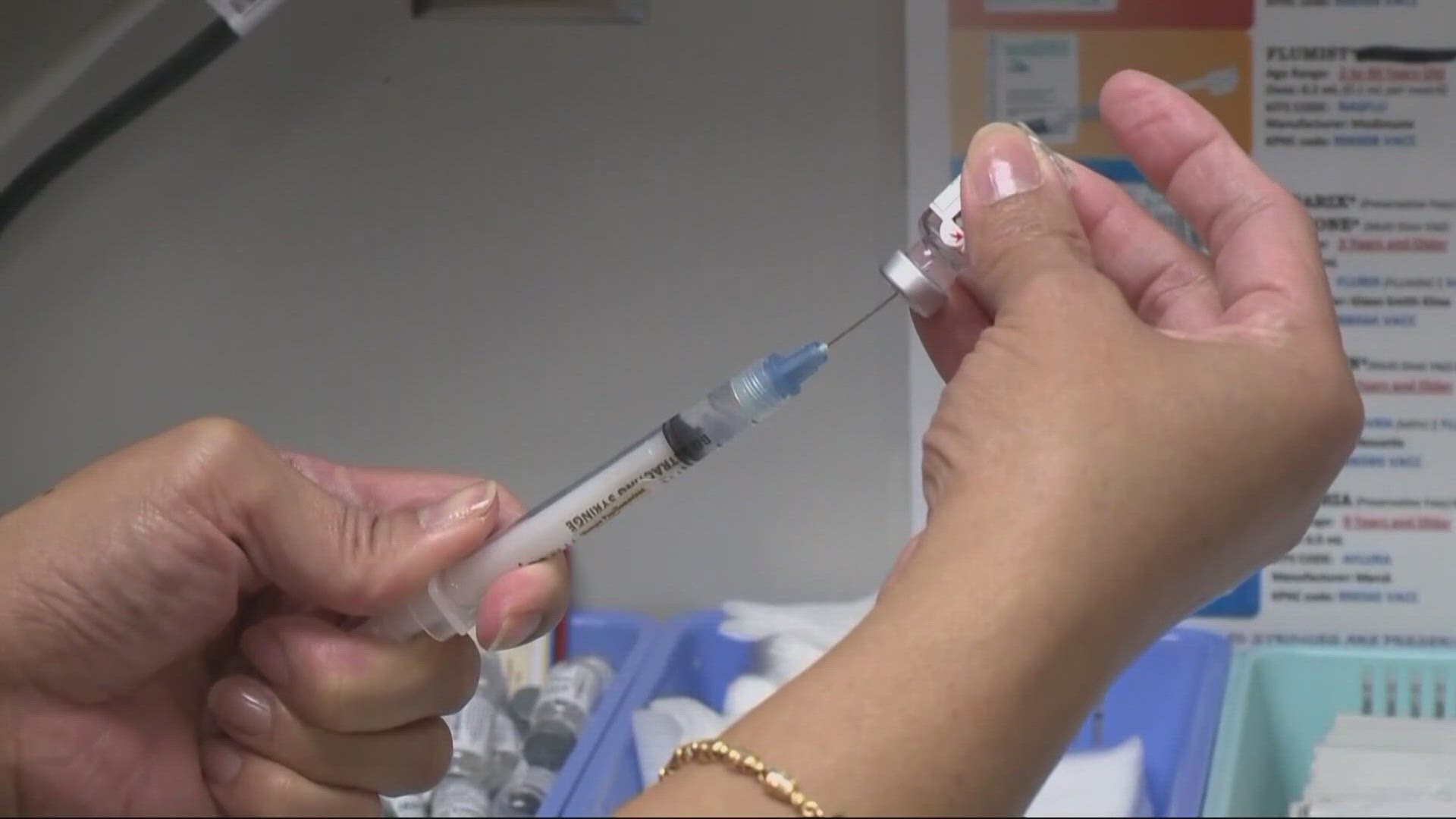PORTLAND, Oregon — Trips to the grocery store and commutes on the MAX might soon require a new accessory: Masks.
The Centers for Disease Control and Prevention and the White House coronavirus task force are contemplating expanding recommendations for wearing masks and face coverings to deter the spread of COVID-19. Current CDC guidelines recommend only that people with symptoms of illness or those caring for people who are sick do so.
But as a growing number of health experts urge people to wear protection to help prevent spread of the virus and positive cases continue to surge across the United States — including in Oregon, where the Oregon Health Authority confirmed 84 new ones Tuesday — the U.S. government is contemplating advising people to wear face coverings at all times in public.
"We are not going to be wearing masks forever, but it could be for a short period of time after we get back into gear,” President Trump said Monday, during a White House briefing. “I could see something like that happening for a period of time.”
The CDC has been reluctant to recommend such a move, in large part because there is a country-wide shortage of medical masks and health-care workers are desperate to stockpile as many as they can. But, according to a report from the Washington Post, the CDC is considering recommending that people adorn do-it-yourself cloth coverings as a way to potentially lower the risk of transmitting the virus and help “flatten the curve.”
Dr. Anthony Fauci, the director of the National Institute of Allergy and Infectious Diseases and a leader of the U.S. response to the pandemic, said during a Tuesday interview on CNN that the task force wanted to make sure changes didn’t negatively affect the supply of masks available to health-care workers before tweaking its recommendations.
“But once we get in a situation where we have enough masks, I believe there will be some very serious consideration about more broadening this recommendation of using masks,” Fauci said. “We’re not there yet, but I think we’re close to coming to some determination.”
While social-distancing and self-isolation remain the primary practices officials are recommending to help curtail the spread of COVID-19, leading local experts on epidemiology insist that wearing masks would also significantly help.
Chunhuei Chi, a professor in the global health program at Oregon State University, said anyone who visits a grocery store, uses public transportation or works or visits a public dwelling with “close contact to other people” should wear a mask at all times — and should have been doing so for weeks.
“Early on, back in February and even up to a week ago, the vast majority of government officials and health authorities were giving out — in my opinion — the wrong message,” Chi said. “They’ve been telling people, ‘Don’t wear masks’ and saying, ‘Masks don’t protect you.’ Well, that’s completely wrong. The masks will protect you.”
Chi said he understood that early government messages were shaped to protect health-care workers. But, he added, there are plenty of ways to create homemade masks, many of which are accessible on YouTube, to help guard against the spread of the virus.
And for those who question the effectiveness of wearing face protection, Chi has one word: Taiwan.
The first coronavirus cases were reported in Taiwan in January, right about the time the first cases were reported in the U.S. But while government officials here delayed action, Chi said, Taiwanese officials moved quickly.
Government officials purchased 92 mask production lines to boost creation, then banned the export and sale of surgical masks. The government became the sole distributor and instituted a rationing system to limit the number people could buy per week. Initially, officials distributed two masks per person per week. In February, that number nudged up to three masks per person per week. And starting April 9, residents will have access to nine masks per adult — and 10 masks per kid — every two weeks.
Taiwan produced an average of 3.2 million masks a day in February. On Tuesday, that number hit 13 million, the same day Taiwan reported just 322 confirmed cases of COVID-19.
“It seemed to control the outbreak very well,” Chi said. “In Taiwan, the vast majority of schools are still open. Students are required to wear masks, but they’re still open. And indoor gatherings are restricted to no more than 100 people. But everyone has masks. It’s helping.”
And now it appears a similar tactic could soon arrive in the U.S., which comes as little surprise to Carlos Crespo, a professor at the OHSU-PSU School of Public Health. “I could see it coming for months,” he said.
Crespo had just finished conducting his first remote lecture on epidemiology Tuesday afternoon, so the issue was fresh on his mind. One of the subjects he discussed with his students involved the tools health experts use to fight the spread of infectious disease. Testing. Social-distancing. Handwashing. And, of course, wearing masks.
“It’s not about whether masks work or not — they could work,” said Crespo, who also is a Vice Provost for undergraduate biomedical research at Portland State. “The issue is: Do we have enough? That’s been the issue from the beginning. If you wear them properly and use them the right way, masks work. But we don’t have enough for health-care workers, those with compromised immune systems and people over 60. So we have to try to be pragmatic and go back to our tool chest and prioritize. What else do we have? Soap. Social distancing. Let’s try that. I hate to be political. But it plays a role in this. If we had more masks from the beginning, we’d be in a better position.
“You need to ramp up production 10 times — a 1,000 times — more than what we’re doing. Nike. Columbia. Adidas. We should have told them to stop making shirts and start making masks. But we didn’t.”
Homemade masks can be effective when used correctly, Crespo said, but there are a couple caveats. They should be washed daily. They should not be shared. They should be stored in a clean and safe place. And they should be kept out of the reach of children.
“But they can be a tool,” he said.
Just not a required tool right now. The OHA on Tuesday refused to take a different stance on the issue, saying that Oregonians should continue to follow current CDC guidelines, which include practicing social-distancing and self-isolation, and “only wear a mask if a healthcare professional recommends it.”
Multnomah County Health Officer Dr. Jennifer Vines offered a similar message, adding that masks should be reserved for frontline workers and health-care professionals who need the equipment to safely do their job.
“As we wait for guidance to be updated, we will continue to say that people who choose to make and wear their own face masks must be aware of their limits,” Vines said, via email. “A mask is not a substitute for regular hand washing, avoiding touching one’s face, physical distancing or staying home when you are sick.”
So masks continue to remain optional. For now.
“OHA will review CDC guidance on the use of masks if or when it changes,” a spokesperson said, via email.
This article was originally published by the Oregonian/OregonLive, one of more than a dozen news organizations throughout the state sharing their coverage of the novel coronavirus outbreak to help inform Oregonians about this evolving health issue.



